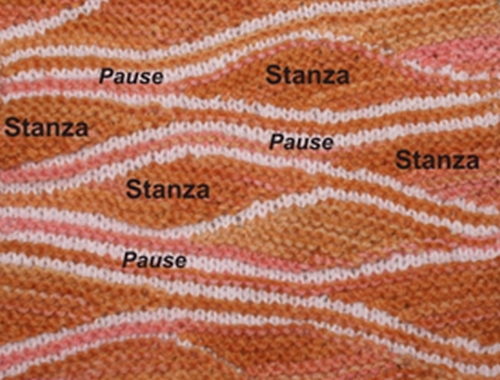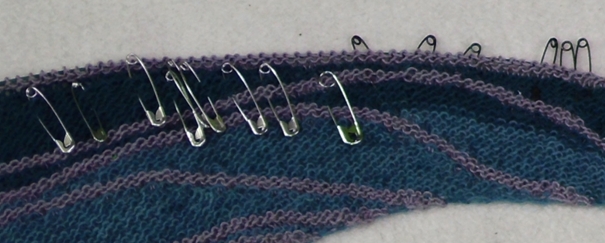Knitting the Swing
| Description | Why this title?
That’s because the knitting technique form swinging stanzas which look like waves and give stunning effects to your knitting. The main technique is to start a short-row-element with always the same amount of stitches and move this row, using a mathematical sequence of numbers for each short-row-field (stanza) of your work. This sequence could be any math sequence you invent, and you follow it throughout the whole project. |
|---|---|
| Has website | http://www.ravelry.com/projects/LanArta?set=art&view=thumbnail |
| Persons working on | Medusa |
| Located at assembly | CCCFr |
| Other projects... | |
Contents
Pimp your knitting with floating elements
Swing-Knitting is a very complex technique. The congress is full of intriguing projects and lectures and there is so little time. That's why we'll give you a sneak preview in the basic techniques, so you are able to knit a little project which you can form to wristlets. Bigger sections will create a cap or a hat and really dilligent knitters may wear a scarf at the end of the congress.
Who can take part?
This is a technique for advanced knitters! You should be experienced in working knit and purl stitches, cast-on / cast-off-techniques, possibly provisional cast-on, kitchener stitch
How are Swing-Knitting stanzas created?
First step is to knit an "inclined plane" which forms the base of the swinging stanzas.
There are some simple rules to learn and follow, and like magic- in the end all your short rows are completed and the knitting is straight again.
Stanzas are always separated by pauses

First of all, you choose the width of the stanza and an algorithm to form the stanza. We don't want you to think of too much theory so I'll propose to provide you with proven details.
The shortening of the rows are merked with safety pins in two colors: light ones for the front side, dark ones for the back side of your knitting.
Once learned the principle vou can combine colors and stanzas to a unique project.
Supplies you need to bring with?
I'd really like to provide you with all supplies but I'm travelling by public transport, so my space is limited. You'll need
- 3-4 yarns in contrasting colors, most comfortable is yarn 100 - 120m/50g
- matching straight needles or a circular (3,5 mm - 4,5mm)
- Safety pins in two different colors (10 of each color)
Yarn and needles for the first 5 participians are available for free!
Please register at the CCCFr Assembly (Hall 3 near iglou) there will be a list for participants.
And please tell us whether you' ll need yarn and needles.
Where is our Meeting-Point?
We'll meet at the CCCFr Assembly and then go to our knitting point. At a space where we have plenty of light and comfortability. I'll check the rooms as soon as I will arrive.
You'll provided with any informations and changes.

